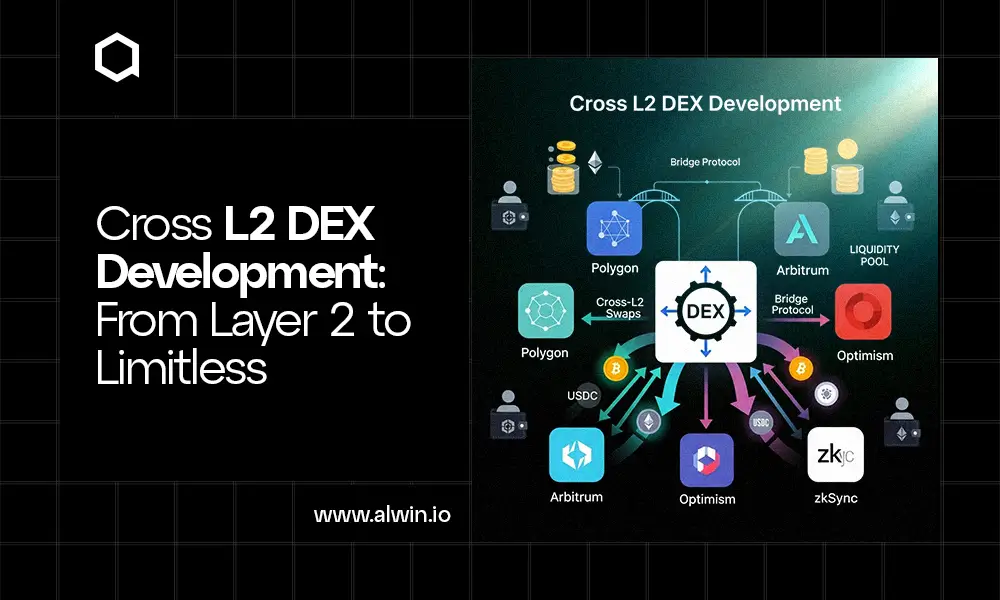Decentralized trading has already come a long way with the rise of DEXs (Decentralized Exchanges). But if you’ve been in the crypto space for a while, you know one of the biggest pain points is high gas fees and slow transactions on popular blockchains like Ethereum. That’s exactly why Layer-2 (L2) scaling solutions came into the spotlight, offering faster and cheaper transactions.
Now, imagine combining that speed and efficiency with the flexibility of trading across multiple Layer-2 networks. That’s where Cross L2 DEX development comes in—the next big leap in decentralized trading. It’s like upgrading from a local road to a multi-lane express highway where users can move their assets flawlessly between different L2s without friction.
In this blog, we’ll break down what Cross L2 DEX actually means, why it’s beneficial for traders, and how it could shape the future of decentralized finance (DeFi).
What is a Cross L2 DEX?
A Cross L2 DEX (Decentralized Exchange) is a trading platform that allows users to swap tokens across different Layer 2 blockchains. To understand this better, let’s break it down:
Layer 2 (L2): These are blockchain networks built on top of a main chain (like Ethereum) to make transactions faster and cheaper. Examples include Arbitrum, Optimism, and zkSync.
DEX (Decentralized Exchange): A platform where people trade cryptocurrencies directly with each other without relying on a central authority like Binance or Coinbase.
Cross L2: This means the DEX lets you trade tokens across multiple Layer 2 networks instead of being stuck on just one.
So, a Cross L2 DEX combines all of these, giving traders the ability to swap assets flawlessly between different Layer 2 blockchains without going back to the expensive main chain (Layer 1).
Example:
Imagine you’re at a shopping mall. Each store accepts only its own gift card, one for clothes, one for food, and one for electronics. Normally, if you want to shop at multiple stores, you’d have to exchange each gift card at a central counter first (slow and costly).
Now imagine there’s a super checkout counter that instantly swaps your gift cards between stores without extra fees or delays. That’s what a Cross L2 DEX does—it lets you move tokens between different “stores” (Layer 2 chains) quickly, cheaply, and without middlemen.
Why Does Business Require Cross-L2 DEX Solutions?
In today’s fast-moving crypto economy, businesses need speed, cost-efficiency, and scalability—and that’s exactly where Cross L2 DEX solutions come in. Traditional decentralized exchanges often face limitations like high gas fees, slower transactions, and restricted access to assets on just one blockchain network. For businesses operating in Web3, this creates friction and limits growth.
A Cross L2 DEX solves these problems by allowing seamless trading across multiple Layer 2 networks without going back to the congested and expensive Layer 1 (like Ethereum mainnet). This means businesses can offer their users lower transaction costs, faster trading speeds, and a much wider choice of assets. For example, a DeFi platform can attract more liquidity providers and traders if it supports cross-chain swaps between Arbitrum, Optimism, and zkSync—all in one place.
Moreover, businesses that adopt Cross L2 DEX solutions can scale globally without sacrificing efficiency. They provide users with a smoother experience, reduce entry barriers, and open doors to new revenue streams. In short, integrating Cross L2 DEX capabilities isn’t just a technical upgrade—it’s a strategic move for staying competitive in the rapidly evolving world of decentralized finance.
Cross L2 DEX Development Company
As a leading Cross L2 DEX development company, we design and deliver advanced solutions that open new avenues for successful trading and a next-generation decentralized ecosystem.
With deep expertise in modular blockchain architecture, our work helps expand your trading opportunities and strengthen your presence in the crypto space. Backed by ongoing blockchain research and a team of seasoned specialists, we combine hands-on experience in DEX development using technology to provide reliable, future-ready solutions.
Features of Cross-L2 DEX Development
Building a Cross L2 Decentralized Exchange (DEX) is not just about enabling token swaps—it’s about creating a seamless, secure, and scalable trading experience across multiple Layer 2 networks. Let’s explore the core features that make Cross L2 DEX development powerful and business-ready:
Multi-Layer 2 Interoperability
The most important feature is the ability to connect multiple Layer 2 blockchains like Arbitrum, Optimism, zkSync, and Polygon zkEVM. Traders can swap assets across these networks without going back to the expensive Layer 1 (Ethereum mainnet).
Low Transaction Fees
By leveraging L2 scalability, transactions are processed at a fraction of the cost compared to traditional DEXs running on Layer 1. This reduces the financial barrier for both retail traders and businesses.
High-Speed Transactions
Cross L2 DEXs are designed for near-instant trades, ensuring users don’t face long waiting times. This speed is especially critical for high-frequency traders and DeFi platforms handling large volumes.
Secure Smart Contracts
Security is at the core of decentralized exchanges. Advanced audited smart contracts govern the trades, ensuring transparency, trust, and protection against fraud or manipulation.
Liquidity Aggregation
Cross L2 DEX platforms often include liquidity aggregation mechanisms, pooling liquidity from multiple Layer 2 networks. This ensures deeper liquidity, tighter spreads, and better trading opportunities.
Cross-Chain Swaps
Users can swap tokens across different Layer 2s without needing centralized bridges. This feature eliminates risks associated with bridge hacks and improves the overall user experience.
User-Friendly Interface
To attract mass adoption, Cross L2 DEXs come with intuitive dashboards, real-time price charts, and easy wallet integration. Even beginners can trade across multiple L2s without confusion.
Governance & Customization
Many Cross L2 DEXs integrate DAO-based governance, allowing communities to participate in decision-making. Businesses can also customize features, tokenomics, and revenue models according to their strategy.
Staking & Yield Farming Options
To boost user engagement and liquidity, staking and yield farming modules can be integrated. This gives traders additional ways to earn rewards while providing liquidity.
Scalability & Future-Proofing
Cross L2 DEXs are built to scale, meaning they can handle millions of trades without lag. Plus, they are designed to integrate with future Layer 2 innovations, ensuring long-term relevance.
How Does a Cross L2 DEX Work?
At its core, a Cross L2 Decentralized Exchange (DEX) is designed to make trading across multiple Layer 2 networks smooth, fast, and cost-efficient. Instead of forcing users to jump back to the expensive Layer 1 (Ethereum mainnet) every time they want to swap tokens between different Layer 2 chains, a Cross L2 DEX uses a mix of smart contracts, bridges, and liquidity pools to simplify the process. Let’s break it down:
Step 1: User Connects Wallet
A trader connects their wallet (like MetaMask) to the Cross L2 DEX. The platform detects which Layer 2 network the user is currently on—say, Arbitrum.
Step 2: Select Token Swap Across L2s
The trader chooses to swap a token (e.g., USDT on Arbitrum) for another token (e.g., ETH on Optimism). Normally, this would require multiple transactions across networks. But here, the Cross L2 DEX handles it directly.
Step 3: Smart Contract Execution
The DEX’s smart contracts kick in, locking the user’s tokens on the source Layer 2 (Arbitrum) and preparing the equivalent amount to be released on the destination Layer 2 (Optimism).
Step 4: Liquidity Pool or Aggregator Matching
Uses its own liquidity pools spread across multiple L2 networks, or connects to external liquidity aggregators to find the best rate for the swap.
This ensures the trade happens at the most efficient price.
Step 5: Settlement Across Networks
Using cross-chain messaging protocols or bridge technology, the system verifies and completes the trade. Tokens are burned or locked on the source chain and minted or unlocked on the destination chain.
Step 6: Instant Token Delivery
The user receives the swapped tokens on the target L2 network (ETH on Optimism) almost instantly, without having to manually move assets through a centralized bridge.
Step 7: Continuous Feedback Loop
Every trade is recorded on-chain, ensuring full transparency and auditability. The system also updates liquidity pools and rates in real time, keeping the market efficient.
Why You Must Approach WeAlwin Technologies for Cross-L2 DEX?
When it comes to building a Cross-L2 Decentralized Exchange (DEX), choosing the right decentralized exchange development company is just as important as the technology itself. This is where WeAlwin Technologies stands out as a trusted blockchain development company with deep expertise in decentralized finance and multi-chain solutions.
At WeAlwin, the focus is on creating scalable, secure, and future-ready DEX platforms that seamlessly connect multiple Layer 2 networks like Arbitrum, Optimism, zkSync, and Polygon zkEVM. With a team of skilled blockchain engineers, smart contract auditors, and UI/UX specialists, they ensure your DEX is not only technically sound but also user-friendly and business-driven.
What makes them unique is their customized approach—understanding your specific business needs and integrating features like cross-chain swaps, liquidity aggregation, yield farming, staking, and DAO-based governance. Whether you’re a startup aiming to launch a niche DeFi product or an enterprise looking to scale globally, WeAlwin provides end-to-end development services—from ideation and architecture design to deployment and ongoing support.
Most importantly, WeAlwin Technologies is committed to security and compliance, two critical pillars for gaining user trust in the DeFi space. By incorporating robust smart contract audits and advanced security protocols, they help safeguard your platform from vulnerabilities and hacks.



